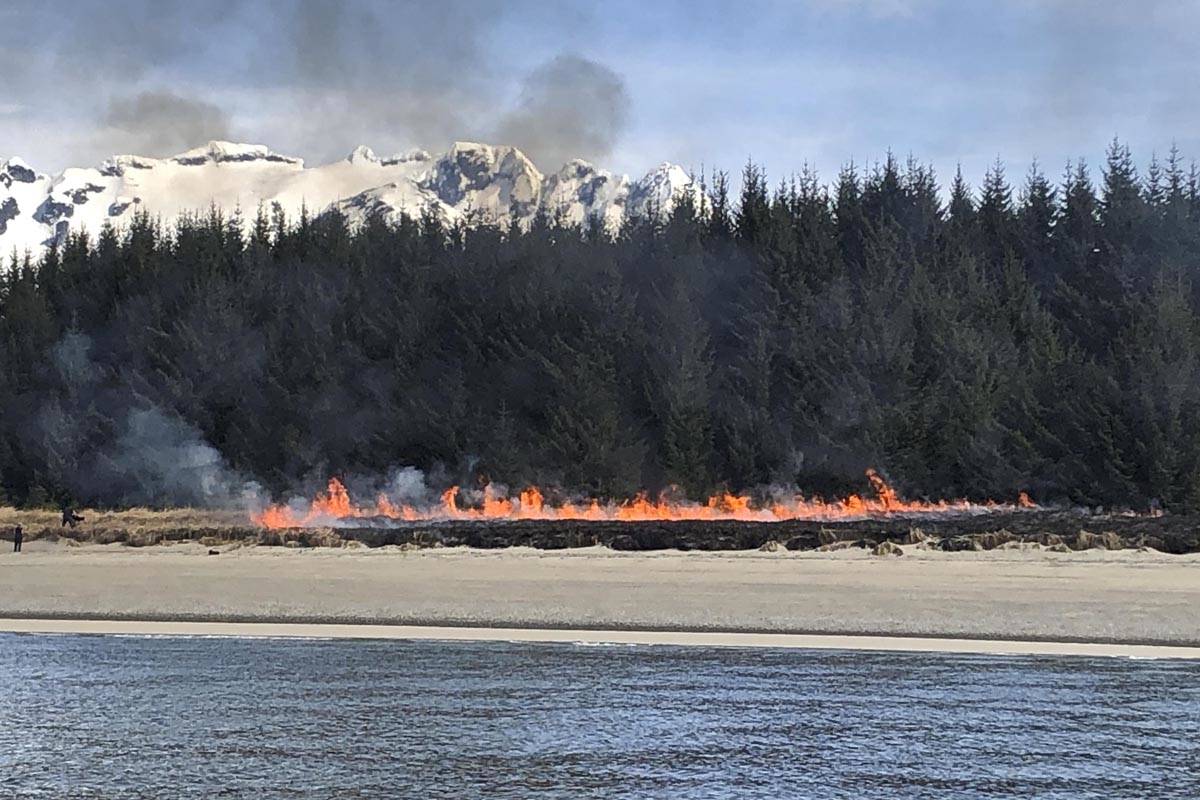The investigation into a wildfire that caught near Crow Point on Saturday continues, said a U.S. Forest Service spokesperson.
“It was human-caused,” said Paul Robbins, a USFS spokesperson in a phone interview. “We don’t have the full results of the investigation, but the vast majority of these fires are accidents.”
No one was hurt by the fire or in suppression efforts, Robbins said, although a USFS firefighter was poked in the eye with a stick. The firefighter is OK, Robbins said.
The fire burned across nearly 16 acres of forest encompassing both state and private land, Robbins said. The fire started growing out of hand slightly before noon, said Brent Tingey, who was boating off the point that is about a mile north of Eagle Beach State Park.
“From 11:45 a.m. to noon… in that time frame, it was really kinda nothing. But by 12.15 p.m., it was getting kind of big,” Tingey said Monday in a phone interview. “The wind was blowing it right up the beach. It’s been a while since I’ve seen a wildfire out there.”
[Forest Services responds to wild fire Saturday]
The wildfire, which grew larger than many wildfires in the Southeast, was fanned by the winds, Tingey said.
“For the Southeast, that’s pretty big,” Robbins said. “Our fires average around a quarter acre, a half acre. Conditions are still fairly dry.”
Personnel from USFS responded to the fire. Capital City Fire/Rescue maintained communications with the USFS firefighters in case they required backup, said CCFR Chief Rich Etheridge in a phone interview.
“We didn’t have any hands-on component,” Etheridge said. “We do have an agreement with the FS, if it’s on the road system, we start the initial attack on it.”
Since this was off the road system and easily attacked from the water, Robbins said, the USFS took the lead.
“That’s what calls us in to fight wildfires around Southeast Alaska, because forest fires are more our specialty than cities or boroughs,” Robbins said. “We are the lead agency for it if it’s a wildfire.”
Drone problems
All six of the USFS’ widely distributed firefighters in Juneau deployed to the fire, Robbins said. They supported suppression of the fire with a jet boat and all-terrain vehicles. A helicopter from Coastal Helicopters also supported operations, Robbins said. However, someone flying a drone in the area caused a temporary halt to helicopter operations, Etheridge said.
“There was a drone that forced our helicopter to shut down operations for a bit for the safety of our helicopter pilot,” Robbins said.
While no one was cited for flying the drone in the operational area, Etheridge said that the penalties faced could be levied by the USFS’ criminal investigative division or the federal government.
“This is a statewide and nationwide problem that people fly drones in because they want to have their own video,” Etheridge said. “It grounds all aircraft operations in the area if there’s any drone activity in the area.”
Police arrest two men following Saturday morning stabbing
Etheridge said the USFS will take the lead in investigating the fire, but that CCFR is happy to assist if the Forest Service asks.
“If they ask for help, our fire marshals will definitely go out and help them,” Etheridge said. ”Depends on who’s in town and what their background is.
We (shouldn’t) start the fire
“This time of year, we get those fast-moving grass fires. Once you get a little fire it spreads really quick,” Etheridge said. “Fortunately, it’s right up on the surface, it moves pretty fast, and it goes out pretty quick.”
The grass and the wind meant Saturday’s fire lit and spread quickly, Etheridge said. To avoid that, people should only have fires on the beaches and in designated areas, such as campfire rings, and to be mindful of the weather conditions and surrounding trees and grass, Robbins said.
“The main thing is to make sure your fire is completely out if you’re having a campfire,” Robbins said. “Only have fires in designated areas.”
The risk of fire danger is still high until the region gets more rain, Robbins said.
• Contact reporter Michael S. Lockett at 757.621.1197 or mlockett@juneauempire.com.

